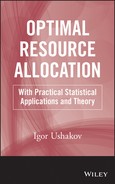Table of Contents
CHAPTER 1: Basic Mathematical Redundancy Models
1.2 Non-repairable Redundant Group with Active Redundant Units
1.3 Non-repairable Redundant Group with Standby Redundant Units
1.4 Repairable Redundant Group with Active Redundant Units
1.5 Repairable Redundant Group with Standby Redundant Units
1.6 Multi-level Systems and System Performance Estimation
1.7 Brief Review of Other Types of Redundancy
1.9 Some Additional Optimization Problems
CHAPTER 2: Formulation of Optimal Redundancy Problems
2.2 Formulation of the Optimal Redundancy Problem with a Single Restriction
2.3 Formulation of Optimal Redundancy Problems with Multiple Constraints
2.4 Formulation of Multi-Criteria Optimal Redundancy Problems
CHAPTER 3: Method of Lagrange Multipliers
CHAPTER 4: Steepest Descent Method
4.2 Description of the Algorithm
CHAPTER 5: Dynamic Programming
CHAPTER 6: Universal Generating Functions
7.2 Structure of Steady-State Genetic Algorithms
CHAPTER 8: Monte Carlo Simulation
8.2 Formulation of Optimal Redundancy Problems in Statistical Terms
8.3 Algorithm for Trajectory Generation
8.4 Description of the Idea of the Solution
8.5 Inverse Optimization Problem
8.6 Direct Optimization Problem
CHAPTER 9: Comments on Calculation Methods
9.2 Sensitivity Analysis of Optimal Redundancy Solutions
CHAPTER 10: Optimal Redundancy with Several Limiting Factors
10.1 Method of “Weighing Costs”
10.2 Method of Generalized Generating Functions
CHAPTER 11: Optimal Redundancy in Multistate Systems
12.1 Spare Supply System for Worldwide Telecommunication System Globalstar
12.2 Optimal Capacity Distribution of Telecommunication Backbone Network Resources
12.3 Optimal Spare Allocation for Mobile Repair Station
CHAPTER 13: Counter-Terrorism: Protection Resources Allocation
13.2 Written Description of the Problem
13.3 Evaluation of Expected Loss
13.4 Algorithm of Resource Allocation
13.5 Branching System Protection
13.7 Measures of Defense, Their Effectiveness, and Related Expenses
13.8 Antiterrorism Resource Allocation under Fuzzy Subjective Estimates
